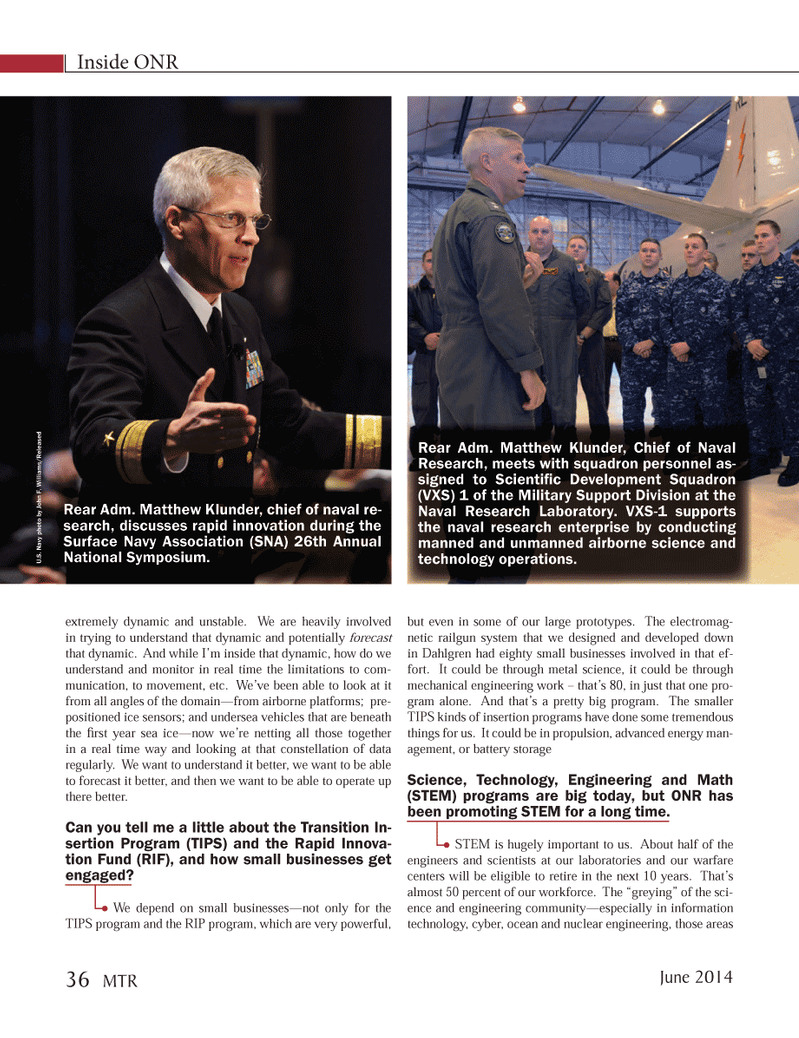
Page 36: of Marine Technology Magazine (June 2014)
Hydrographic Survey
Read this page in Pdf, Flash or Html5 edition of June 2014 Marine Technology Magazine
Inside ONR extremely dynamic and unstable. We are heavily involved in trying to understand that dynamic and potentially forecast that dynamic. And while I’m inside that dynamic, how do we understand and monitor in real time the limitations to com- munication, to movement, etc. We’ve been able to look at it from all angles of the domain—from airborne platforms; pre- positioned ice sensors; and undersea vehicles that are beneath the fi rst year sea ice—now we’re netting all those together in a real time way and looking at that constellation of data regularly. We want to understand it better, we want to be able to forecast it better, and then we want to be able to operate up there better.
Can you tell me a little about the Transition In- sertion Program (TIPS) and the Rapid Innova- tion Fund (RIF), and how small businesses get engaged? We depend on small businesses—not only for the
TIPS program and the RIP program, which are very powerful, but even in some of our large prototypes. The electromag- netic railgun system that we designed and developed down in Dahlgren had eighty small businesses involved in that ef- fort. It could be through metal science, it could be through mechanical engineering work – that’s 80, in just that one pro- gram alone. And that’s a pretty big program. The smaller
TIPS kinds of insertion programs have done some tremendous things for us. It could be in propulsion, advanced energy man- agement, or battery storage
Science, Technology, Engineering and Math (STEM) programs are big today, but ONR has been promoting STEM for a long time. STEM is hugely important to us. About half of the engineers and scientists at our laboratories and our warfare centers will be eligible to retire in the next 10 years. That’s almost 50 percent of our workforce. The “greying” of the sci- ence and engineering community—especially in information technology, cyber, ocean and nuclear engineering, those areas
Rear Adm. Matthew Klunder, Chief of Naval
Research, meets with squadron personnel as- signed to Scientifi c Development Squadron (VXS) 1 of the Military Support Division at the
Naval Research Laboratory. VXS-1 supports the naval research enterprise by conducting manned and unmanned airborne science and technology operations.U.S. Na vy photo b y John F . Williams/R eleased
Rear Adm. Matthew Klunder, chief of naval re- search, discusses rapid innovation during the
Surface Navy Association (SNA) 26th Annual
National Symposium.
June 2014 36 MTR
MTR #5 (34-49).indd 36 6/9/2014 10:36:53 AM

 35
35

 37
37
